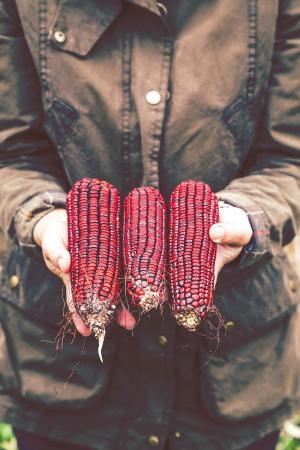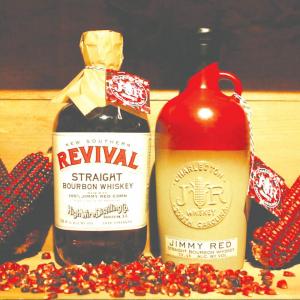2022 - Volume #46, Issue #1, Page #17
[ Sample Stories From This Issue | List of All Stories In This Issue | Print this story
| Read this issue]
Nearly Lost Corn Variety Comes Back
 |
 |
“Like so many landraces, Jimmy Red expressed different traits,” explains Glenn Roberts, Anson Mills.
Roberts has long championed heritage grain and legume landraces once popular in the Southeast. Landraces are varieties that have been selected for desired traits and adapted to a particular area. Roberts has grown rare seeds into quantities sufficient for his own milling company, and he has also shared them with countless others across the country. Rescues include John Haulk, an Appalachian heirloom corn, Carolina Gourdseed White corn and Carolina Gold rice.
He points out that there are only about 30 rice varieties in the U.S. today. He juxtaposes that with more than 100 distinct landraces known within 30 miles of Charleston, S. C. in 1803. His Carolina Gold is one of the few survivors.
Such landrace cultivars not only represent the past but, with their rich genetic heritage, may provide hope for the future. While modern crops are developed for specific growing conditions, landraces adapt to climate change.
“This past season was a rotten year for commercial wheat, but our landrace wheats had a great year,” says Roberts.
In the case of Jimmy Red, Anson credits Ted Chewning with preservation. Chewning, a seed saver and advocate of seed sharing, lives on James Island, S.C. A family there had long grown Jimmy Red to make moonshine. When they stopped, they gave a few ears of the corn to Chewning. He grew them out and shared some with Roberts and others who rebuilt reserves of the unique landrace over the next 18 years and put them to use in restaurants and distilleries alike.
“Ted and I selected four or five separate cultivars, which I kept distinct,” says Roberts. “Ted put them all back together and focused on milling traits.”
Chewning shared his with Charleston chef Sean Brock, who made it a nationally recognized celebrity cultivar. Roberts shared the darkest and sweetest selection with Scott Blackwell of High Wire Distilling. In 2014, 2 1/2 acres were grown out. Over the next two years, Blackwell turned that into 570 bottles of bourbon. It sold out in 11 min.
“This past fall, Sean harvested 218,000 lbs. of Jimmy Red, and High Wire Distillery has contracted more than a million pounds for 2022,” says Roberts. “Sean’s cultivar is the best for milling, while the best ‘hooch’ corn is always the darkest and heaviest test weight.”
Roberts’ cultivars run 63-lb. test weight on average with yields of 50 to 70 bushels per acre. Jimmy Red is a 105 to 115-day corn with 10 to 12-in. ears on 8 to 10-ft. tall plants. The sugars that made it ideal for moonshine also make it good for eating fresh roasted or matured and ground for meal and grits.
To grow and develop his own collections and encourage others to do the same, Roberts has worked with seed preservationists, as well as USDA and university researchers. He occasionally shares rice seed with farmers in the U.S. South, as well as for biosecurity for underserved communities internationally.
Roberts doesn’t sell seed, but he does share it with various heirloom seed companies like FEDCO Seeds and Baker Creek Seeds, non-profits like the Southern Seed Exchange and other low-profit seed providers.
“We choose to give the seed away to these groups to keep it in the public domain,” says Roberts. “We’ve donated seed in some way or other to pretty much all the seed companies in the East, Midwest and even the Southwest.
Roberts encourages people to try growing heritage varieties in their areas. However, he notes that local conditions affect flavor. Sometimes flavor can change within a field.
“Mineral changes in the soil within a 30-ft. distance can change the flavor,” he explains. “Landraces react to micro sweet spots and alter the taxonomy, including height and leaf size. In native cultures, seeds were hand-selected for how they would react to an area.”
“If FARM SHOW readers can’t find it elsewhere, I do offer 100 true type, Jimmy Red starter seeds to farmers who develop their own crops,” offers Roberts. “It has been grown successfully in the middle Hudson Valley, Missouri, southeast Texas and I understand also on the West Coast. It expresses its traits perfectly everywhere, even up to 5,000-ft. elevation, if there is enough heat for the season.”
Contact: FARM SHOW Followup, Anson Mills, 1922 C Gervais St., Columbia, S.C. 29201 (ph 803-467-4122; www.ansonmills.com) or Baker Creek Heirloom Seed Co., 2278 Baker Creek Rd., Mansfield, Mo. 65704 (ph 417-924-8917; seeds@rareseeds.com; www.rareseeds.com) or Marsh Hen Mill, 2995 Hwy 174, Edisto Island, S.C. 29438 (ph 843-603-0074; www.marshhenmill.com)

Click here to download page story appeared in.

Click here to read entire issue
To read the rest of this story, download this issue below or click here to register with your account number.




